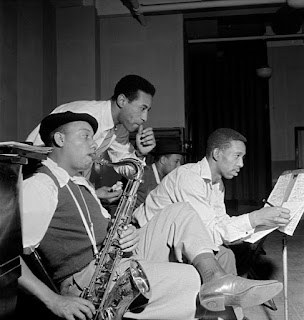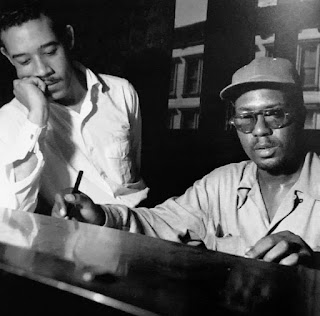The Thelonious Monk Sextet – May 30 1952
Ira Gitler – The Complete Genius Liner Notes – BNLA-579-H2 – 1975
Monk's last date as a leader for Blue Note (May 1952) is exactly like his first in instrumentation but very different in feeling due to the sidemen and the material. Blakey may be perfect for Monk but Max Roach, in his way, is perfection, too, Monk's refashioning of Carolina Moon into a 6/4 waltz was perhaps the most celebrated number from this session when it came out on 78 and Roach was no small help in the realization of the concept.
Each one of the three Monk originals is an entity unto itself and a success on its own terms. Hornin' In has a keening, other worldly ensemble sound but is earthy enough in its solo sections. Monk knows how to extract sound from a group through subtle voicings and from a piano by techniques that make a note elastic without being "plastic."
Skippy's wondrously intricate theme is established by the piano before the horns enter in an arcing swell. Lucky Thompson's Byased (out of Hawkins) opinions are followed by a pensive Kenny Dorham who gathers momentum like a good relay man as he passes the baton to Monk whose solo is so meaty that I recommend many listenings for full digestion. On the way out the horns carry the theme before cresting again on that sonic wave.
 |
| Alfred Lion and Thelonious Monk Photo by Francis Wolff |
Let's Cool One mellows along after a most musical cymbal introduction by Roach. Kenny Dorham is the essence of elegant cool, treading surefootedly on the padded feet of a hip cat. Lou Donaldson (not heard in solo on Skippy) blithely splits a chorus with Thompson and Monk shares his with bassist Nelson Boyd.
Ira Gitler – Genius of Modern Music Volume 2 Liner Notes – BLP 1511 – March 1956
As composer-arranger for the sextet, Monk shows another facet of his skill. The 6/4 waltz that he makes of Carolina Moon is an example of how to get away from the usual jazz beat and still swing. Donaldson, Kenny Dorham and Lucky Thompson help considerably in the realization of this attempt (to say nothing of Max Roach) and make their solo power felt in the other numbers, Hornin' In, Skippy and Lei’s Cool One. Contrast these sextet tracks with the exact instrumentation of the Suburban Eyes group and you’ll see where Monk has continued to grow while still remaining tho individual personality who leads and influences modern music and its makers.
 |
| Lucky Thompson, Max Roach, Lou Donaldson and Kenny Dorham at rehearsal Photo by Francis Wolff |
Michael Cuscuna – More Genius of Thelonious Monk Liner Notes – BNJ-61011
The album closes with five selections from Monk's final Blue Note date in 1952. This is one of the least recognized and most spectacular of Monk's career. First of all, the tunes are so incredible that few have attempted to play them since. Secondly, Monk is at his most complex and astonishing as a pianist. The impossible "Skippy" is offered in an alternate take that has one of the most amazing of Monk's career with layers and layers of ideas and textures. An impossibly brilliant solo on an impossible tune to play. Likewise on his beautifully orchestrated "Hornin' In", his solo is a total achievement, a passing view of his genius. And here Lou Donaldson seems to shine brighter than he does on the master take.
"Sixteen" is quite the discovery. Monk had never recorded or performed this tune before or after this session. An undiscovered Monk composition actually laid for decades in the Blue Note vaults!
"I'll Follow You" is a tentative, absorbing reading of a forgotten standard by the team that wrote "Mean To Me". This discovery is Monk's only performance of the tune.
Here then is a worthy addition to the most exciting period in the life on of one of Jazz's most exciting creators: Thelonious Sphere Monk.
 |
| Nelson Boyd, Lucky Thompson, Max Roach and Kenny Dorham Photo by Francis Wolff |
Bob Blumenthal – RVG CD Reissue Liner Notes (5 32139 2) – 2001
Monk's May 30, 1952 session was his final one as a leader for Blue Note, and is one of the most underrated of his entire career. While it was originally intended to be released as a 10" LP containing all six titles, "Sixteen" and "I’ll Follow You" went unissued for three decades, while the other four masters first appeared as 78s and received their initial LP release on the 12" version of Genius Volume Two. The sextet instrumentation of Monk's initial Blue Note session is revisited, albeit with more organic results and eloquent soloists. The latter include trumpeter Kenny Dorham, best known at the time for his work with Charlie Parker; alto saxophonist Lou Donaldson, who was introduced to the wider jazz world via Milt Jackson's previously noted Blue Note session in April and would get the first of his own numerous dates for the label in June; and tenor saxophonist Lucky Thompson, then leading a band at the Savoy Ballroom. Two more Parker quintet alumni, Nelson Boyd (one of the period's mainstay bassists) and Max Roach (as compatible in his way as Blakey was with Monk's conception) complete the blue-ribbon assemblage.
"Skippy" immediately exploits the orchestral possibilities of the sextet in a wonderful arrangement. The complex tritone theme, a 32-bar ABAC structure, is played at the opening by Monk and the rhythm section until the horns enter in a descending cadence at bar 25 and then separate for a series of climactic calls. After the solos, the full sextet plays the entire melody with glorious precision. Thompson, Dorham and Monk take a chorus each on both the earlier master and the slightly slower alternate, with Monk displaying the greatest consistency of invention, Dorham sticking to similar ideas, and Thompson in his swing-to-bop transitional mode.
 |
| Max Roach and Nelson Boyd at rehearsal Photo by Francis Wolff |
Both takes of "Sixteen" (named for the number of measures in its chorus and based on the hoary "Why Do You Do Me?" chord sequence that Sonny Rollins also appropriated for "Doxy") initially appeared together shortly after Monk's death. The Donaldson/Dorham/Thompson/Monk solo sequence is identical on each, with the saxophones taking two choruses while trumpet and piano take one. Donaldson is once again more impressive on the earlier take, while Dorham begins his solo on the second version (presented as the master here) by quoting Monk's "Well You Needn't."
Roach's polyrhythmic magic is central to the triumph of "Carolina Moon," as it had been on Bud Powell's "Un Poco Loco" a year earlier. The drummer's 6/4 groove on the theme chorus was particularly unprecedented in a period when few jazz musicians played waltzes. While each soloist does well Dorham's incredibly soulful half-chorus deserves singling out.
Drums and trumpet are again inspired on "Let's Cool One," as is the entire sextet. Thompson's entrance is memorable, and Boyd gets a rare eight bar solo. The title, a catch phrase of disc jockey Ralph Cooper, fits one of Monk's most relaxed compositions to perfection.
The 1932 pop song "I'll Follow You," performed without the horns, also went unissued until 1983. Monk seeks out the interesting angles in what others might simply view as a maudlin theme, and with a typically iconoclastic stroke inserts the verse after the initial theme statement.
Michael Cuscuna – The Complete Blue Note Recordings of Thelonious Monk – Mosaic Records MR4-101
Monk’s final date as leader for Blue Note is a very special one in many ways. The material is varied and, for the most part, complex and unique. Monk brought charts to the studio and used the three horns to best advantage with voicings that seem integral to the compositions. This may be why most of them were never performed again by Monk, whose working situation was limited to a quartet.
Monk’s earlier sessions had already been collected into 10” lps and Blue Note recorded six sides here, exactly enough for a new 10” album. Yet the company never issued Sixteen or I’ll Follow You. So the other four titles languished on 78’s, a fading format, until they made it to 12” in 1956. Even then, they were not fully recognized, perhaps because Riverside was by then documenting equally ambitious sessions like the Brilliant Corners LP.
 |
| Max Roach and Thelonious Monk Photo by Francis Wolff |
This is the first of three occasions on which Max Roach would record with Monk. At the end of 1952, he would play on one of Monk’s trio dates for Prestige, and, in 1956 he would be an important element in the three sessions that made up Brilliant Corners. Nelson Boyd was one of several bassists that had worked on Monk’s live gigs in the forties.
The three hornmen were not commonly associated with Monk and did not record or work with him thereafter. It is most likely that Kenny Dorham was the trumpeter on the mysterious Frankie Passions record that is commonly dated as 1950 or ‘51. Lou Donaldson’s presence might have been prompted by Alfred Lion, who would record the altoist as a leader three weeks later, beginning an association between Donaldson and Blue Note that lasted until 1975 with only one interruption. Lucky Thompson was, at this time, freelancing actively in several jazz circles in New York.
 |
| Thelonious Monk Photo by Francis Wolff |
Down Beat 23 September 1953 Volume 20 Issue 19
Tasty dishes of cucumber and peanut-butter, served by a svelte sextet, with Kinny Dorham, Lou Donaldson, and Lucky Thompson making an expressive front line. (Blue Note 1602)
Down Beat 4 November 1953 Volume 20 Issue 22
Carolina Moon, a good choice, would have made it except for the lengthy, ill-advised unison opening. The underlying polyrhythm is interesting, though, and warrants further exploration. Rest of the side has good choruses by Kinney Dorham, Lou Donaldson, Lucky Thompson, and a brief comment from Monk.
Hornin’ In, a Monk original, never gets started. Perhaps more than three minutes are needed to expand Monk’s original themes in general, e.g., Jimmy Raney’s eloquent extension of Round About Midnight. Only Dorham blows with much conviction on this side, though Monk, Nelson Boyd, and Max Roach provide a good beat. These were recorded May 30, 1952. (Blue Note 1603)
Session Information
Kenny Dorham, trumpet #1-8; Lou Donaldson, alto sax #1-8; Lucky Thompson, tenor sax #1-8; Thelonious Monk, piano; Nelson Boyd, bass; Max Roach, drums.
WOR Studios, NYC, May 30, 1952
BN434-1 tk.2, Skippy, Blue Note 1602, BLP 1511
BN434-2 tk.3, Skippy (alt)
BN435-1 tk.5, Hornin' In (alt)
BN435-3 tk.7, Hornin' In, Blue Note 1603, BLP 1511
BN436-0 tk.8, Sixteen
BN436-1 tk.9, Sixteen (alt)
BN437-0 tk.10, Carolina Moon, Blue Note 1603, BLP 1511
BN438-0 tk.11, Let's Cool One, Blue Note 1602, BLP 1511
BN439-0 tk.12, I'll Follow You










No comments:
Post a Comment